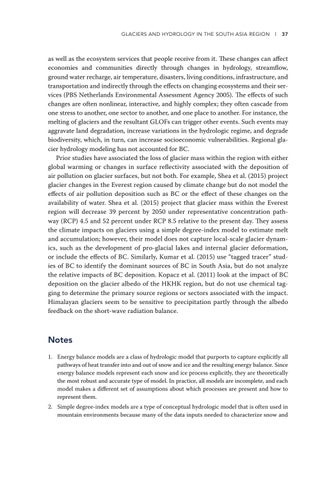Glaciers and Hydrology in the South Asia Region l 37
as well as the ecosystem services that people receive from it. These changes can affect economies and communities directly through changes in hydrology, streamflow, ground water recharge, air temperature, disasters, living conditions, infrastructure, and transportation and indirectly through the effects on changing ecosystems and their services (PBS Netherlands Environmental Assessment Agency 2005). The effects of such changes are often nonlinear, interactive, and highly complex; they often cascade from one stress to another, one sector to another, and one place to another. For instance, the melting of glaciers and the resultant GLOFs can trigger other events. Such events may aggravate land degradation, increase variations in the hydrologic regime, and degrade biodiversity, which, in turn, can increase socioeconomic vulnerabilities. Regional glacier hydrology modeling has not accounted for BC. Prior studies have associated the loss of glacier mass within the region with either global warming or changes in surface reflectivity associated with the deposition of air pollution on glacier surfaces, but not both. For example, Shea et al. (2015) project glacier changes in the Everest region caused by climate change but do not model the effects of air pollution deposition such as BC or the effect of these changes on the availability of water. Shea et al. (2015) project that glacier mass within the Everest region will decrease 39 percent by 2050 under representative concentration pathway (RCP) 4.5 and 52 percent under RCP 8.5 relative to the present day. They assess the climate impacts on glaciers using a simple degree-index model to estimate melt and accumulation; however, their model does not capture local-scale glacier dynamics, such as the development of pro-glacial lakes and internal glacier deformation, or include the effects of BC. Similarly, Kumar et al. (2015) use “tagged tracer” studies of BC to identify the dominant sources of BC in South Asia, but do not analyze the relative impacts of BC deposition. Kopacz et al. (2011) look at the impact of BC deposition on the glacier albedo of the HKHK region, but do not use chemical tagging to determine the primary source regions or sectors associated with the impact. Himalayan glaciers seem to be sensitive to precipitation partly through the albedo feedback on the short-wave radiation balance.
Notes 1. Energy balance models are a class of hydrologic model that purports to capture explicitly all pathways of heat transfer into and out of snow and ice and the resulting energy balance. Since energy balance models represent each snow and ice process explicitly, they are theoretically the most robust and accurate type of model. In practice, all models are incomplete, and each model makes a different set of assumptions about which processes are present and how to represent them. 2. Simple degree-index models are a type of conceptual hydrologic model that is often used in mountain environments because many of the data inputs needed to characterize snow and




